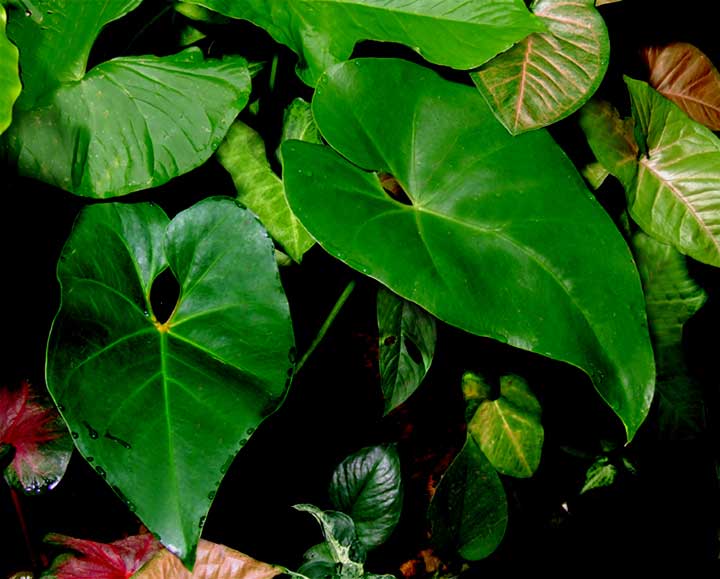![]()
Aroids and other genera in the Collection
Take the Tour Now?
Orchids
The
Exotic Rainforest
Plants in
the Exotic Rainforest Collection
The images on this website are copyright protected. Please contact us before any reuse.
Detailed information on Growing Anthurium Species
Click this Link
Within our collection we have many species of Anthurium. If you are seeking other photos, click this link
New: Understanding, pronouncing and using Botanical terminology, a Glossary
Anthurium cordatum (L.) Schott

In the Spring of 2006 Florida aroid collector Russ Hammer sent a very nice anthurium for which he had been trying to find an ID. His only clue was it came from the Virgin Islands. After a lengthy list of emails to the Caribbean and a confusing attempt at species research I believe I've tracked the species down. According to sources in the Virgin Islands the plant is Anthurium cordatum and is common to the Lesser Antilles. It is also found in the Leeward and Caribbean Windward Islands. Many of these islands have wet forests where the governments of those islands say this plant is known to exist. Those include the Virgin Islands, Saba, St. Eustatius, St. Lucia, St. Vincent and the Grenadines. Some information also indicates the plant is found in portions of South America including Venezuela. I've been unable to find a lot of scientific information regarding the species. Sources in the Caribbean say it is a natural hybridizer and can be found in the islands with a variety of known growth forms. As a result of the multiple growth forms the plant has a large number of synonyms (same plant known by other scientific names). Interestingly, almost all of those names were given to the plant by the same botanist! That is not unlike many other tropical species. In fact, the excellent text AROIDS, Plants of the Arum Family says the plant is actually Anthurium leuconeurum! But then the text goes on to say A. leuconeurum is likely a natural hybrid so figure that confusing statement out! Sounds like this plant has had a very confused nomenclatural history. Anthurium species are known to be highly variable and not every leaf of every specimen will always appear the same. This link explains in greater detail the scientific principle of natural variation and morphogenesis. Click here.
The leaf blades are coriaceous (quite thick and leathery) with the feel of rubber. The plant is a self header that apparently does not readily climb. However, information from the Virgin Islands indicates it is found both as an epiphyte (ep-a-FIT) growing on trees as well as a terrestrial plant especially on the island of St. John. Commonly known as the "heartleaf" Anthurium in those islands the plant is said to be common in moist forest areas. A. cordatum produces interesting foliage that islanders say is sometimes home to tree snails and nests of wasps known as "Jack Spaniards". An interesting note also came from the islands, the plant is often known as a "trash basket" plant. That is not an uncommon description for an Anthurium. This plant has a habit of having roots that aim upwards in to capture falling plant material and biological debris. It does that in to have that matter decay around the base and provide a source of both nutrients and moisture retention.
An aroid, all Anthurium species reproduce via the production an inflorescence. The stalk that supports the entire inflorescence is the peduncle. When an Anthurium is "in flower" the reference is to the tiny flowers containing both male and female sexual parts that grow on the spadix at the center of the inflorescence. Unlike Philodendron species which contain imperfect flowers having only a single sex Anthurium possess perfect flowers containing both sexes. To help prevent self pollination nature has designed the female flowers to be receptive before the male flowers produce their pollen so in most cases an insect must bring pollen from another plant. The spathe which surrounds the fleshy spadix is not a flower but is instead a modified leaf. The flowers actually form on the spadix which is at the center of the spathe.
The heartleaf Anthurium purportedly produces a long pointed reddish-green (some sources say tending towards purple) inflorescence and spadix but as yet we have not seen one on the plant Russ sent for our collection. Some government photos show Anthurium cordatum growing in large clumps and at least one photo shows it growing quite tall with petioles (stems) over 3 feet (90cm) long. Since the islands that are home to this Anthurium are quite humid and wet at least some of the year we have found conditions in our Exotic Rainforest to be ideal. We have A. cordatum planted amongst a group of anthuriums where it receives filtered light. Since most of the islands have a dry season during the winter we will allow the plant to dry some during that portion of the year. The species is acknowledged by both TROPICOS (Missouri Botanical Garden) and the International Plant Names Index, however little detailed scientific information is available.
Join the International Aroid Society: http://www.exoticrainforest.com/Join%20IAS.html
Need more information on Anthurium species?
Click this link.